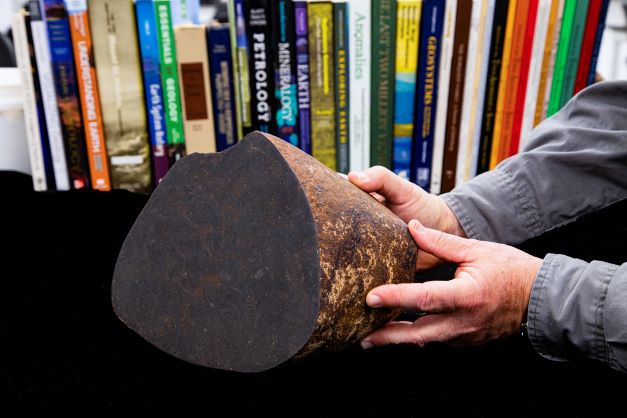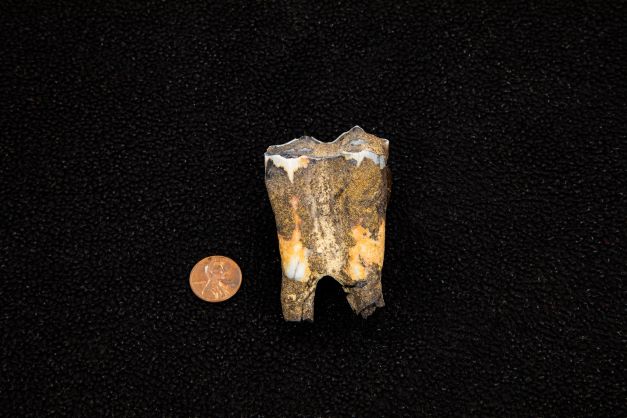UTRGV Planetarium and Geology Lab
VISIT THE LA VILLA METEORITE AT THE UTRGV H-E-B PLANETARIUM
https://www.utrgv.edu/planetarium/

With an original mass of 19.8 kg (43.65 lbs), this meteorite was found by a farmer while plowing his field. The piece is rounded and ellipsoidal in shape, with one fairly flat surface, indicating that it probably broke during entry into the earth’s atmosphere. It has no outstanding features or pittings, only a 3 mm thick hydrated ferric oxide crust.
Geochemical analysis of a 1.2 kg portion of the meteorite is the basis for classifying it as “an ordinary chondrite from the H group that is petrologic type 4.” Ordinary chondrites are a major class of stony meteorites. H group refers to high iron content of ~90%, and type 4 signifies chondrites that are characterized by abundant chondrules (olivine and pyroxene crystals).
The timing of the landing on earth of this meteorite is uncertain but based on the thin oxide crust and the fact that it was found near the surface suggest it probably took place within the last several thousand years. If it happened at night, there is chance that inhabitants of the Rio Grande Valley witnessed a fireball it produced as it entered the atmosphere. The age is estimated to be 4.5 billion years, formed as part of our solar system, making it the oldest object in south Texas. A small portion is held by the Smithsonian Institution, but the main piece of the meteorite resides at the UTRGV planetarium in Edinburg, Texas, where it can be viewed by the public.
The La Villa is one of 313 formally recognized meteorites from Texas, and one of 1868 meteorites from the United States.
SEE THE PLEISTOCENE MEGAFAUNA REMAINS AT THE UTRGV GEOLOGY LAB

IN SOUTH TEXAS EVIDENCE OF PLEISTOCENE MEGAFAUNA IS MOSTLY FRAGMENTARY AND COMES IN THE FORM OF ACCIDENTAL FINDS OF MAMMOTH, GIANT BISON, AND GIANT GOPHER TORTOISE REMAINS.
Evidence of Bison latifrons (also known as the giant bison or long-horned bison) in the Rio Grande Valley comes in the form of a molar and multiple small fragments of bones found on a ranch north of Edinburg. The bones were radiocarbon dated at 22,700 years before present.
B. latifrons was the largest and heaviest bovid ever to live in North America. It measured 4.7 m (16 ft) in length and stood about 2.5 m (8.2 ft) tall at the withers, with an estimated weight of 2,000 kg (4,400 lbs). It roamed from Alaska to Mexico but became extinct 30,000 to 20,000 years ago at the beginning of the last glaciation.
UTRGV COLLEGE OF SCIENCES: SCHOOL OF EARTH, ENVIRONMENTAL, AND MARINE SCIENCES
INTEGRATED SCIENCE FOR AN INTEGRATED WORLD
SEEMS offers Bachelor of Science (B.S.) degrees in Environmental Science, Marine Biology, and Sustainable Agriculture and Food Systems, as well as a minor in Geology. Students may also elect a curriculum geared towards a Teaching Certification (Secondary Education). SEEMS also offers Master of Sciences (M.S.) degrees in Agricultural, Environmental, and Sustainability Sciences (AESS) and Ocean, Coastal, and Earth Sciences (OCES). All degree programs take advantage of the unique and exciting coupled human-natural systems of the Lower Rio Grande Valley watershed and south Texas' coastal, estuarine, and marine ecosystems.

